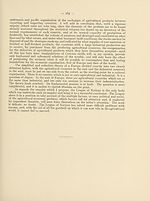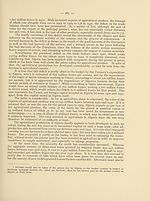Download files
Complete book:
Individual page:
Thumbnail gallery: Grid view | List view

ALGERIA
M. G. J. STOTZ
Honorary Director of the School of Agriculture of Algiers.
Agriculture in Algeria could hardly suffer more than in the mother country from the
effects of the fall in prices on the world market, since Algeria is protected by the same
Customs regime. But Algeria has been suffering from a crisis of her own, mainly due to
the vicissitudes of her inconstant climate and also to her economic evolution and
organisation. ..... • ^ i j .
Two very different systems may be distinguished in Algerian agricultural production.
the native system and the European system. The latter, known as the colonisation
system, produces a gross yield of 16 quintals of all products to the hectare,
the former yields 6 quintals to the hectare. While the colonisation system concentrates
on viticulture, the native system is confined to the growing of cereals, stock-breeding and
the cultivation of certain trees such as the fig, the olive and the date-palm, antiquated
methods being followed with insufficient equipment. Out of about 4.5 million hectares
under cultivation, 62 per cent is cultivated under the native and 38 per cent under the
European system; and out of an aggregate production of 4 to 4.5 million tons, 53 per cent
is produced by the European and 47 per cent by the native system.
About one-third of this production is exported, 62 per cent being represented by
wine, 19 per cent by cereals, 2.5 per cent by cattle, and 16.5 per cent by various products,
mainly dried vegetables, potatoes, fresh vegetables, citrus fruits and dates. The value ol
these exports represents about 83 per cent of the total exports, which came to a yearly
average of 3,633 million francs for the period 1925 to 1929, as against i,54p inillion
francs1 for the period 1901 to 1910; in 1930 it rose as high as 4,552 million francs, including
2 232 million francs in various agricultural products and 1,776 million francs in wine.
The average annual value of the imports for 1925 to 1929 rose to 4,689 million francs,
against 1,971 million francs for the period 1901 to 1910, and to 5,829 million francs m
1930 Foodstuffs were responsible for 17.4, 21 and 18.3 per cent respectively of the total
imports during the periods 1925 to 1929, 1901 to 1910 and 1930. Since 1928 imports have
shown an appreciable increase in the number of tons of building materials (cement, tiles,
marble, glasswork, iron and other metal work, etc.), mineral and lubricating oils, bar-steel,
sheet-iron, copper and lead; soap, wax candles, tallow candles; paper, machinery (especially
for flour-mills), railway material and articles in cast-iron. On the other hand, 1930 showed
a setback in imports of motor-cars, tractors and agricultural implements, clothing and
luxuries. Expenditure is being cut down in Algeria as in France.
The result is that Algeria is suffering from a deficit of her trade balance, the fluctuations
of which depend, generally speaking, on the size of the good or bad harvests, and, especial y
during the last few years, on the activity of the building trade m the towns and the
extension of vineyards, a distinguishing feature of the present period. During 1925 to
1929 this deficit averaged 1,066 million francs yearly, as against 431 million francs
for the period 1901 to 1910, and reached 1,980 million francs in 1929, before sinking to
1 In this note all values are estimated in francs at the current rate of exchange.
M. G. J. STOTZ
Honorary Director of the School of Agriculture of Algiers.
Agriculture in Algeria could hardly suffer more than in the mother country from the
effects of the fall in prices on the world market, since Algeria is protected by the same
Customs regime. But Algeria has been suffering from a crisis of her own, mainly due to
the vicissitudes of her inconstant climate and also to her economic evolution and
organisation. ..... • ^ i j .
Two very different systems may be distinguished in Algerian agricultural production.
the native system and the European system. The latter, known as the colonisation
system, produces a gross yield of 16 quintals of all products to the hectare,
the former yields 6 quintals to the hectare. While the colonisation system concentrates
on viticulture, the native system is confined to the growing of cereals, stock-breeding and
the cultivation of certain trees such as the fig, the olive and the date-palm, antiquated
methods being followed with insufficient equipment. Out of about 4.5 million hectares
under cultivation, 62 per cent is cultivated under the native and 38 per cent under the
European system; and out of an aggregate production of 4 to 4.5 million tons, 53 per cent
is produced by the European and 47 per cent by the native system.
About one-third of this production is exported, 62 per cent being represented by
wine, 19 per cent by cereals, 2.5 per cent by cattle, and 16.5 per cent by various products,
mainly dried vegetables, potatoes, fresh vegetables, citrus fruits and dates. The value ol
these exports represents about 83 per cent of the total exports, which came to a yearly
average of 3,633 million francs for the period 1925 to 1929, as against i,54p inillion
francs1 for the period 1901 to 1910; in 1930 it rose as high as 4,552 million francs, including
2 232 million francs in various agricultural products and 1,776 million francs in wine.
The average annual value of the imports for 1925 to 1929 rose to 4,689 million francs,
against 1,971 million francs for the period 1901 to 1910, and to 5,829 million francs m
1930 Foodstuffs were responsible for 17.4, 21 and 18.3 per cent respectively of the total
imports during the periods 1925 to 1929, 1901 to 1910 and 1930. Since 1928 imports have
shown an appreciable increase in the number of tons of building materials (cement, tiles,
marble, glasswork, iron and other metal work, etc.), mineral and lubricating oils, bar-steel,
sheet-iron, copper and lead; soap, wax candles, tallow candles; paper, machinery (especially
for flour-mills), railway material and articles in cast-iron. On the other hand, 1930 showed
a setback in imports of motor-cars, tractors and agricultural implements, clothing and
luxuries. Expenditure is being cut down in Algeria as in France.
The result is that Algeria is suffering from a deficit of her trade balance, the fluctuations
of which depend, generally speaking, on the size of the good or bad harvests, and, especial y
during the last few years, on the activity of the building trade m the towns and the
extension of vineyards, a distinguishing feature of the present period. During 1925 to
1929 this deficit averaged 1,066 million francs yearly, as against 431 million francs
for the period 1901 to 1910, and reached 1,980 million francs in 1929, before sinking to
1 In this note all values are estimated in francs at the current rate of exchange.
Set display mode to:
![]() Universal Viewer |
Universal Viewer | ![]() Mirador |
Large image | Transcription
Mirador |
Large image | Transcription
Images and transcriptions on this page, including medium image downloads, may be used under the Creative Commons Attribution 4.0 International Licence unless otherwise stated. ![]()
| League of Nations > Economic and financial section > Agricultural crisis > Volume 1 > (168) |
|---|
| Permanent URL | https://digital.nls.uk/190904834 |
|---|
| Shelfmark | LN.II.2/2.(35) |
|---|---|
| Attribution and copyright: |
|
| Shelfmark | LN.II.2/2.(35-35) |
|---|---|
| Shelfmark | LN.II |
|---|
| Description | Over 1,200 documents from the non-political organs of the League of Nations that dealt with health, disarmament, economic and financial matters for the duration of the League (1919-1945). Also online are statistical bulletins, essential facts, and an overview of the League by the first Secretary General, Sir Eric Drummond. These items are part of the Official Publications collection at the National Library of Scotland. |
|---|---|
| Additional NLS resources: |
|

